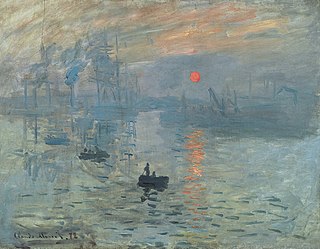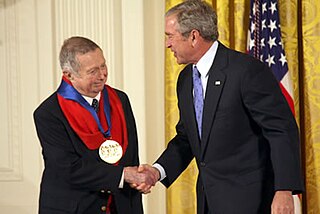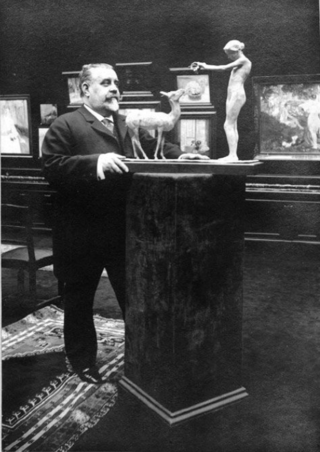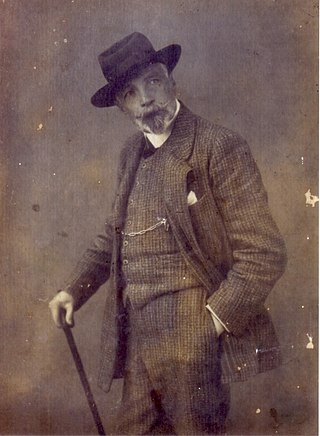
Impressionism was a 19th-century art movement characterized by relatively small, thin, yet visible brush strokes, open composition, emphasis on accurate depiction of light in its changing qualities, ordinary subject matter, unusual visual angles, and inclusion of movement as a crucial element of human perception and experience. Impressionism originated with a group of Paris-based artists whose independent exhibitions brought them to prominence during the 1870s and 1880s.
Action painting, sometimes called "gestural abstraction", is a style of painting in which paint is spontaneously dribbled, splashed or smeared onto the canvas, rather than being carefully applied. The resulting work often emphasizes the physical act of painting itself as an essential aspect of the finished work or concern of its artist.

Pat Boran is an Irish poet.

George Clair Tooker, Jr. was an American figurative painter. His works are associated with Magic realism, Social realism, Photorealism, and Surrealism. His subjects are depicted naturally as in a photograph, but the images use flat tones, an ambiguous perspective, and alarming juxtapositions to suggest an imagined or dreamed reality. He did not agree with the association of his work with Magic realism or Surrealism, as he said, "I am after painting reality impressed on the mind so hard that it returns as a dream, but I am not after painting dreams as such, or fantasy." In 1968, he was elected to the National Academy of Design and was a member of the American Academy of Arts and Letters. Tooker was one of nine recipients of the National Medal of Arts in 2007.
Robert Motherwell was an American abstract expressionist painter, printmaker, and editor of The Dada Painters and Poets: an Anthology. He was one of the youngest of the New York School, which also included Willem de Kooning, Jackson Pollock, and Mark Rothko.

Jacques Joseph Tissot, better known as James Tissot, was a French painter, illustrator, and caricaturist. He was born to a drapery merchant and a milliner and decided to pursue a career in art at a young age, coming to incorporate elements of realism, early Impressionism, and academic art into his work. He is best known for a variety of genre paintings of contemporary European high society produced during the peak of his career, which focused on the people and women's fashion of the Belle Époque and Victorian England, but he would also explore many medieval, biblical, and Japoniste subjects throughout his life. His career included work as a caricaturist for Vanity Fair under the pseudonym of Coïdé.

Hans Hofmann was a German-born American painter, renowned as both an artist and teacher. His career spanned two generations and two continents, and is considered to have both preceded and influenced Abstract Expressionism. Born and educated near Munich, he was active in the early twentieth-century European avant-garde and brought a deep understanding and synthesis of Symbolism, Neo-impressionism, Fauvism, and Cubism when he emigrated to the United States in 1932. Hofmann's painting is characterized by its rigorous concern with pictorial structure and unity, spatial illusionism, and use of bold color for expressive means. The influential critic Clement Greenberg considered Hofmann's first New York solo show at Peggy Guggenheim’s Art of This Century in 1944 as a breakthrough in painterly versus geometric abstraction that heralded abstract expressionism. In the decade that followed, Hofmann's recognition grew through numerous exhibitions, notably at the Kootz Gallery, culminating in major retrospectives at the Whitney Museum of American Art (1957) and Museum of Modern Art (1963), which traveled to venues throughout the United States, South America, and Europe. His works are in the permanent collections of major museums around the world, including the Metropolitan Museum of Art, Tate Modern, Germanisches Nationalmuseum, National Gallery of Art, and Art Institute of Chicago.

Giovanni Muzzioli was an Italian painter primarily known for his work in the fields of painting and book illustration. Muzzioli gained recognition for his depictions of various subjects, including portraits, landscapes, and historical scenes, often reflecting a blend of realism and idealism.

Aldo Renato Guttuso was an Italian painter and politician. He is considered to be among the most important Italian artists of the 20th century and is among the key figures of Italian expressionism. His art is characterized by social and political commentary, and as a member of the Italian Communist Party (PCI) he became its senator for two legislatures, from 1976 to 1983, during Enrico Berlinguer's secretariat.
The Bay Area Figurative Movement was a mid-20th-century art movement made up of a group of artists in the San Francisco Bay Area who abandoned working in the prevailing style of Abstract Expressionism in favor of a return to figuration in painting during the 1950s and onward into the 1960s.
Rodolfo Ceccotti is an Italian painter and printmaker. After teaching in Carrara, he became a lecturer in Printmaking Techniques at the Fine Art Academy in Florence. Since 1996, he has also been Director of Studies at the Scuola Internazionale per la Grafica d'Arte Il Bisonte in Florence.

Georges Petit was a French art dealer, a key figure in the Paris art world and an important promoter and cultivator of Impressionist artists.
Gerry Murphy is an Irish poet.

Giovanni Battista Lusieri (1755–1821) was an Italian landscape painter from Naples. He was court painter to Ferdinand I of the Two Sicilies before working for Thomas Bruce, 7th Earl of Elgin and becoming involved in the removal and shipping of the Elgin Marbles to England.
Aurelio Tiratelli was an Italian painter, mainly of country scenes with animals.

Alexandre-Auguste Robineau, born April 23, 1747 in Paris where he died January 13, 1828, is a French painter and musician, Priest-Catholic.
Dedalus Press is one of the major publishers of contemporary poetry in Ireland.

Michele Catti was an Italian artist, considered one of the most important Sicilian landscape painters of the Belle Époque.
Nicola De Maria is an Italian painter living and working in Torino, Italy. De Maria is known for his abstract figurative works, which have been characterized as lyrical and colourful.

Femme au béret et à la robe quadrillée is an oil-on-canvas painting by Pablo Picasso, which he created in 1937. It is a portrait of Marie-Thérèse Walter, Picasso's lover and muse during this period and was created with elements of Cubism. The painting signifies a transition in their relationship by combining Walter's profile with that of Picasso's new lover, the Surrealist photographer Dora Maar, with whom he began a relationship in 1936. This portrait was produced in the same year as Guernica and The Weeping Woman, a significant phase in Picasso's artistic career. On 28 February 2018, it was sold at Sotheby's auction for £49.8 million, making it one of the most expensive paintings ever sold at an auction in Europe.











